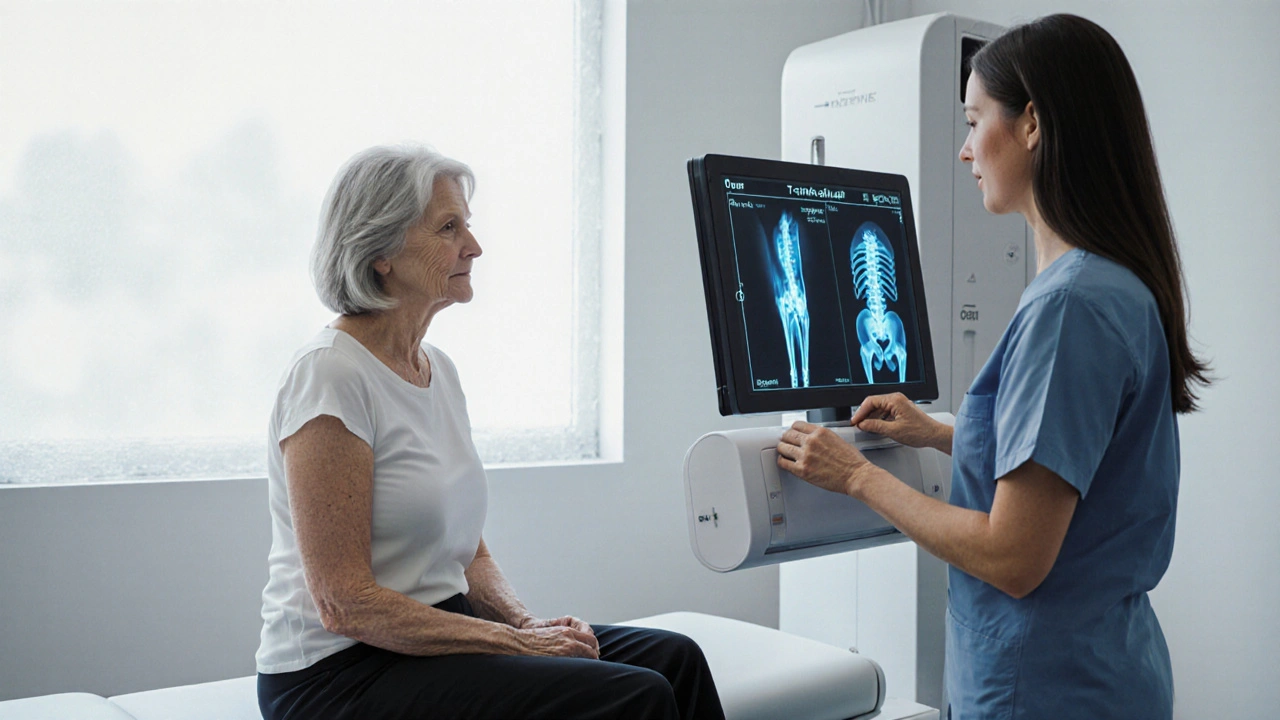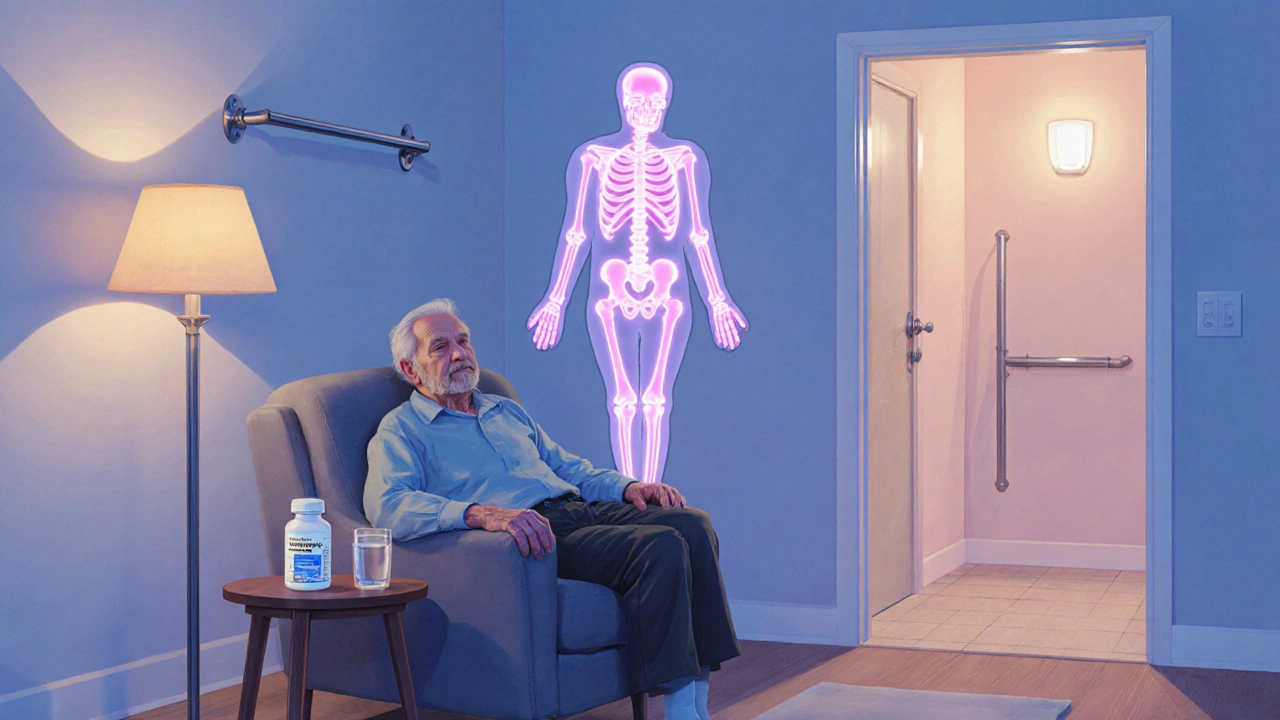Early Detection and Treatment of Osteoporosis: Why It Matters

Quick Takeaways
- Osteoporosis often shows no symptoms until a fracture occurs.
- Screening with a bone density test can catch the disease years before a break.
- Calcium, vitamin D, and weight‑bearing exercise cut risk by up to 30%.
- Bisphosphonates are the most common first‑line medicines, reducing fracture rates by 40‑50%.
- Early action means fewer hospital stays, lower medical costs, and better quality of life.
When it comes to bone health, osteoporosis is a condition marked by low bone mass and structural deterioration, which makes bones fragile and prone to breaks affects more than 200 million people worldwide. The scary part? Most people don’t feel a thing until a fracture-often at the hip, wrist, or spine-forces them into surgery or long‑term disability. That’s why catching the disease early can change the whole story.
Why Early Detection Saves Lives
Research from the International Osteoporosis Foundation shows that a hip fracture costs the healthcare system an average of CAD30,000 per patient in Canada, plus months of reduced independence. Detecting osteoporosis when bone density has already dipped but before a break occurs can halve that cost. Early discovery also means you can start lifestyle changes and medication while the bones are still relatively strong, improving the chance of preserving mobility.
How Osteoporosis Develops
Bone is a living tissue that constantly remodels itself. Young adults build bone faster than they lose it, reaching peak bone mass around age 30. After that, a subtle imbalance-more breakdown than buildup-begins. Hormones, especially estrogen, play a big part. When estrogen levels drop during menopausethe natural cessation of menstrual cycles, typically in a woman’s late 40s to early 50s, bone loss can accelerate up to 2% per year.
Who Is Most at Risk?
Risk isn’t limited to older women. Men over 70, people with a family history of fractures, smokers, heavy drinkers, and those on long‑term steroids all face higher odds. Even a seemingly healthy 45‑year‑old with low calciuman essential mineral that provides the structural framework for bones intake can end up with fragile bones.

Screening Tools: Choose the Right Test
The gold‑standard for diagnosing osteoporosis is the dual‑energy X‑ray absorptiometry (DEXA) scan, a type of bone mineral density testthat measures bone density at the hip and spine with a tiny radiation dose. It provides a T‑score that compares your bone density to a healthy 30‑year‑old. A score of -2.5 or lower confirms osteoporosis.
| Method | Radiation | Accuracy | Typical Cost (CAD) | Best For |
|---|---|---|---|---|
| DEXA (Hip & Spine) | Very low | High (±1-2%) | 120-200 | Definitive diagnosis |
| Quantitative Ultrasound (Heel) | None | Moderate | 30-60 | Initial screening, especially in community settings |
| Peripheral DEXA (Forearm) | Low | Good for follow‑up | 80-130 | Monitoring treatment response |
If you’re under 65 with no risk factors, many guidelines suggest waiting until you’re 70 before a routine DEXA. However, women who have gone through menopausethe natural decline of estrogen hormones or anyone on glucocorticoids should get screened at 50 or even earlier.
Nutrition: Calcium and Vitamin D Matter
Calcium alone isn’t enough; you need vitamin Da fat‑soluble vitamin that helps the gut absorb calcium and supports bone remodeling to make the mineral work. The Canadian Society for Exercise Physiology recommends 1,000mg of calcium and 800-1,000IU of vitamin D daily for adults over 50. Dairy, fortified plant milks, leafy greens, and safe sun exposure are reliable sources.
Exercise: Load Your Bones
Weight‑bearing activities-walking, jogging, dancing-stimulate bone formation. Resistance training, using bands or free weights, adds extra stress that tells bones to become denser. Aim for at least 150 minutes of moderate aerobic activity plus two strength sessions per week, as supported by a 2023 meta‑analysis that showed a 24% reduction in vertebral fractures among active seniors.

Treatment Options After Diagnosis
If your DEXA shows osteoporosis, doctors typically start with bisphosphonatesa class of drugs that slow bone resorption, such as alendronate or zoledronic acid. Clinical trials report a 40-50% drop in hip and vertebral fractures after three years of use. For people who can’t tolerate oral tablets, an annual IV infusion of zoledronate is a convenient alternative.
Other prescription options include selective estrogen receptor modulators (SERMs) like raloxifene, parathyroid hormone analogs (teriparatide), and in some cases, hormone replacement therapy for early‑post‑menopausal women. Your doctor will weigh benefits against risks such as atypical femur fractures or jaw osteonecrosis, which are rare but worth monitoring.
Managing Fracture Risk Beyond Medication
Even with meds, you still need to reduce fall hazards. Simple changes-installing grab bars, removing loose rugs, using a night‑light-cut fall rates by roughly one‑third. Vision checks, balance exercises (tai chi, yoga), and regular physical therapy keep muscles strong and reflexes sharp.
When a fracture does happen, early orthopedic intervention and a structured rehab plan can restore function faster. A multidisciplinary approach-physician, physiotherapist, dietitian-has been shown to improve post‑fracture quality of life by up to 25%.
Putting It All Together: Your Action Plan
- Check Your Risk: List personal factors-age, sex, family history, medication use.
- Schedule a Screening: If you’re a woman over 50 or a man over 70, book a DEXA. Earlier if you have risk factors.
- Boost Nutrition: Aim for 1,000mg calcium and 800-1,000IU vitamin D daily.
- Get Moving: Do weight‑bearing cardio and resistance training at least three times a week.
- Talk Treatment: If diagnosed, discuss bisphosphonates or alternatives with your doctor.
- Fall‑Proof Your Home: Install grab bars, improve lighting, keep pathways clear.
- Follow‑Up: Repeat DEXA every 2-3 years to monitor progress.
Taking these steps early not only prevents painful breaks but also saves you from costly procedures and lost independence. The sooner you act, the stronger your bones stay.
Frequently Asked Questions
Can men get osteoporosis?
Yes. While women are more commonly affected, men over 70 and those on long‑term steroids have a substantial risk. Early screening is recommended for high‑risk males.
How often should I have a bone density test?
If you have normal results and no new risk factors, repeat the test every 2-3 years. Those on medication may need yearly checks.
Are calcium supplements enough to prevent fractures?
Supplements help meet daily needs, but they work best alongside vitamin D, weight‑bearing exercise, and, when needed, medication.
What are the side effects of bisphosphonates?
Common issues include stomach irritation and rare events like atypical femur fractures or jaw osteonecrosis. Taking the pill with plenty of water and staying upright for 30 minutes reduces stomach problems.
Can I reverse osteoporosis?
You can improve bone density and lower fracture risk, but the underlying loss of peak bone mass isn’t fully reversible. Early treatment maximizes gains.